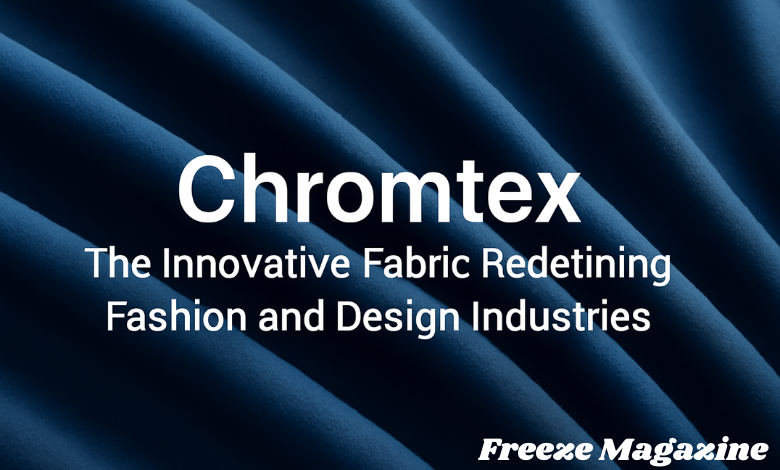Chromtex: The Innovative Fabric Redefining Fashion and Design Industries
Introduction
In the world of textiles, designers are always on the lookout for the next big thing—something that offers a blend of function, form, and innovation. While classic materials like silk, cotton, and denim have stood the test of time, there’s a newer fabric quietly gaining traction in design studios and production lines worldwide: Chromtex. Though not yet a household name, Chromtex is poised to become a game-changer in the fashion, design, and manufacturing industries.
In this blog post, we will dive deep into what Chromtex is, its characteristics, and why it’s generating so much buzz among designers and manufacturers alike. As the textile industry continues to evolve, this material is setting new standards for both aesthetics and functionality. Here’s everything you need to know about Chromtex and why it might soon be a staple in the world of design.
What Is Chromtex?
Chromtex is a synthetic textile material that is quickly making a name for itself in various creative fields. It stands out due to its unique combination of durability, flexibility, and visual appeal. The fabric is engineered to offer enhanced performance features without compromising on style, making it highly attractive to designers who are looking to push the boundaries of their work.
The creation of Chromtex is rooted in both science and artistry. It’s crafted using a proprietary process that blends advanced polymer technology with innovative weaving techniques. As a result, Chromtex not only has superior strength but also a unique texture that can mimic the look and feel of natural materials while offering a range of design possibilities that traditional fabrics cannot match.
The Origins of Chromtex
Chromtex’s origins lie in the development of high-performance materials that combine aesthetics with functionality. Initially, the fabric was created with the intention of providing a more sustainable alternative to existing materials that didn’t meet the growing demands of modern design. As environmental concerns and the push for more eco-friendly production methods have grown, Chromtex represents a step forward in reducing the environmental impact of textile production.
In addition to its sustainability, Chromtex is designed to offer better versatility and resilience compared to its predecessors. It was initially designed with applications in the fashion industry in mind but quickly found its place in other areas of design, including automotive interiors, high-performance outdoor gear, and even furniture design.
Characteristics of Chromtex
What makes Chromtex so distinct from other fabrics? There are several defining characteristics that set it apart and contribute to its growing popularity:
1. Durability and Strength
One of the standout features of Chromtex is its exceptional durability. Unlike many traditional fabrics, Chromtex can withstand prolonged exposure to wear and tear. It resists abrasion, fading, and stretching, making it an ideal choice for applications that demand longevity. This durability is particularly important in industries where materials are subjected to heavy use, such as in the automotive, sports, and outdoor sectors.
2. Lightweight Yet Strong
Despite its robust nature, Chromtex remains lightweight. This combination of strength and lightness makes it easy to work with in a variety of applications, from clothing to upholstery. Designers are drawn to the fabric’s ability to deliver a high-performance material without the bulkiness typically associated with other strong fabrics.
3. Flexibility
Chromtex offers a high degree of flexibility. Whether used for intricate fashion designs or larger structural projects, this fabric’s flexibility allows it to be shaped and manipulated in ways that other materials cannot. It can be used for products that require molding or bending, such as in the case of automotive interiors, where curves and bends are a common design element.
4. Aesthetic Appeal
While performance is a top priority for Chromtex, its aesthetic qualities are equally important. The fabric can be finished in a variety of ways, from matte to glossy, and can be treated to achieve different textures, including smooth, grainy, or even quilted effects. This versatility allows designers to explore a wide range of visual styles while maintaining the material’s integrity.
5. Sustainability
Sustainability is a central concern for many industries, including textiles. Chromtex addresses this issue by being an eco-conscious alternative to other materials. It is manufactured with sustainable practices, and its production involves less waste compared to traditional textile manufacturing. Additionally, it’s designed to be recyclable, further reducing its environmental impact.
6. Versatility
Chromtex is incredibly versatile, which is part of what makes it so appealing to designers. It can be used in everything from fashion garments to home décor, automobile upholstery, and even electronic cases. Its unique properties make it a material of choice for industries seeking performance coupled with visual elegance.
Applications of Chromtex
As Chromtex continues to gain popularity, its applications are expanding across a variety of industries. Some of the key areas where Chromtex is making an impact include:
1. Fashion Design
In the fashion world, Chromtex is being used for high-performance garments and accessories. Whether it’s athletic wear that needs to withstand the rigors of exercise or fashion-forward pieces that incorporate innovative design features, Chromtex provides the best of both worlds. Its strength, flexibility, and aesthetic appeal make it a favorite material for designers looking to create durable yet stylish pieces.
2. Automotive Interiors
Chromtex has found a particular niche in the automotive industry. Due to its resilience and ability to mimic natural leather or textiles, it is used for car interiors, including seats, dashboards, and trims. Unlike traditional materials, Chromtex’s superior durability and ease of maintenance make it a more practical solution for vehicle interiors. It also allows automakers to offer a range of designs, from luxurious to sporty, without compromising on quality or performance.
3. Furniture Design
In furniture design, Chromtex is being used in everything from couches to office chairs. Its ability to withstand daily wear and tear, along with its aesthetic appeal, makes it a top choice for interior designers looking for materials that will last while providing an elegant finish. Chromtex is also resistant to stains, which makes it particularly useful for furniture in public spaces or homes with children and pets.
4. Sports and Outdoor Gear
Outdoor enthusiasts are taking notice of Chromtex for its performance-oriented properties. The material’s durability and resistance to the elements make it ideal for outdoor gear, such as tents, backpacks, and jackets. Designers are incorporating Chromtex into their collections because it can stand up to harsh weather conditions while still maintaining comfort and style.
5. Tech Accessories
Chromtex has also found its place in the tech industry. The fabric is being used for cases, bags, and sleeves for electronics, including laptops, tablets, and phones. Its sleek look, combined with durability, provides a modern, professional aesthetic that many consumers are seeking in their tech accessories. Additionally, its resistance to wear and scratches makes it an attractive alternative to other materials used in tech products.
Why Chromtex Is Gaining Popularity
The growing popularity of Chromtex can be attributed to a few key factors. First, it offers a combination of performance and aesthetics that few materials can match. Designers no longer have to choose between a material that looks good but is fragile or one that is durable but lacks style. Chromtex bridges the gap by offering both.
Second, sustainability is a significant driver of its adoption. As consumers and manufacturers alike become more eco-conscious, Chromtex presents an attractive alternative to traditional fabrics that may be less environmentally friendly. The fabric’s recyclable nature, along with the reduced waste during production, makes it a sustainable choice for modern consumers.
Finally, Chromtex’s versatility makes it an appealing option across a wide range of industries. Whether it’s high fashion, outdoor gear, or automotive interiors, Chromtex offers something for every designer looking to innovate and create with new materials.
Conclusion
As the world of design continues to evolve, Chromtex is emerging as a fabric that will define the next generation of textiles. With its perfect balance of durability, flexibility, aesthetics, and sustainability, it offers a wide array of possibilities for designers across different fields. As more industries begin to adopt this versatile material, it’s likely that Chromtex will continue to grow in prominence, becoming a go-to fabric for both performance and beauty in the coming years.
Whether you’re a designer looking for the next big thing in textiles, or simply someone curious about what materials are shaping the future of design, Chromtex is a fabric to watch closely.
FAQS
1. What is Chromtex made from?
Chromtex is a synthetic fabric created using advanced polymer technology and innovative weaving techniques for enhanced durability and flexibility.
2. What industries use Chromtex?
Chromtex is used in fashion, automotive interiors, furniture design, outdoor gear, and tech accessories due to its versatility.
3. Is Chromtex sustainable?
Yes, Chromtex is designed with sustainability in mind, featuring recyclable properties and reduced production waste compared to traditional textiles.
4. What makes Chromtex different from other fabrics?
Chromtex combines strength, flexibility, lightweight properties, and aesthetic appeal, offering a balance of performance and design versatility.
5. How durable is Chromtex?
Chromtex is highly durable, resistant to abrasion, fading, and stretching, making it ideal for high-performance and long-lasting applications.





Post Comment